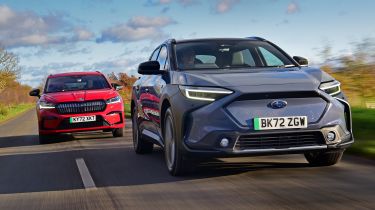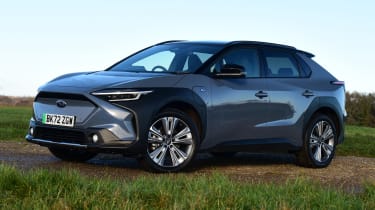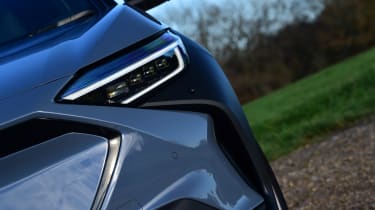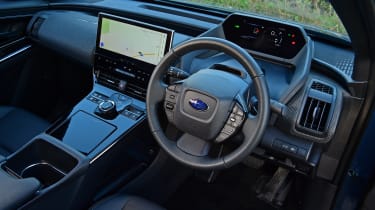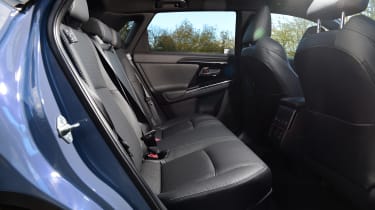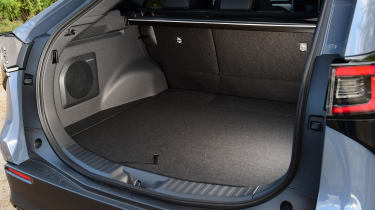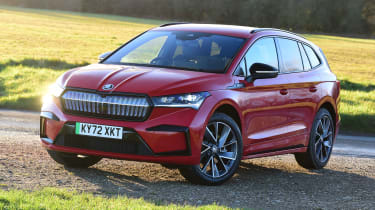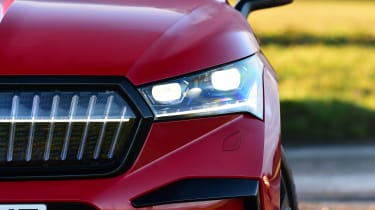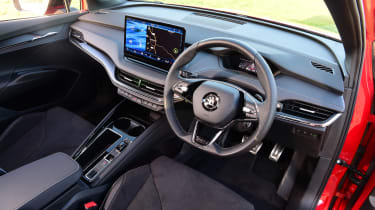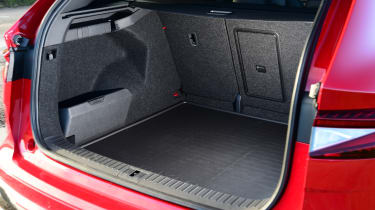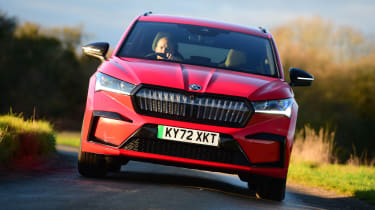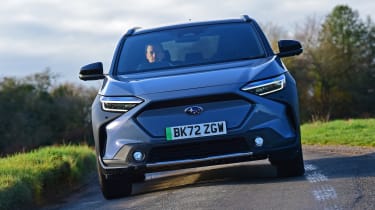Subaru Solterra vs Skoda Enyaq: 2023 twin test review
The Solterra marks Subaru’s first step into electrification. Can it beat the Skoda Enyaq?
Sales of fully electric cars continued to grow in 2022, and for the first time ever in the UK, EV registrations overtook those of diesels, with a 14 per cent market share comfortably beating the 10.6 per cent taken by diesel-powered models. That trend is only set to continue in 2023, when new brands from China will make their way to UK shores for the first time.
However, one of the latest arrivals in the all-electric sector comes with a familiar name from Japan. The Subaru Solterra is the company’s first venture into the world of full EVs, but it’s not entirely its own work. In fact, a big part of it is Toyota’s; badges aside, the Solterra is virtually identical to the bZ4X, although the brands did work together on the car’s development.
But if Subaru is to continue to function in the future, it needs to offer the sort of rugged, dependable cars that its buyers are so loyal towards – even if that means they come without a combustion engine.
To see how the Solterra fares, we’ve put it up against one of the most competitive family EVs on the market. The Skoda Enyaq iV has many of the qualities that the Subaru needs to emulate if it wants to succeed. And as we’ll discover, there are a couple of weaknesses that the newcomer can exploit, too.
Used - available now

2023 Audi
A3 Sportback
19,678 milesManualPetrol1.0L
Cash £17,324
2024 Audi
A3 Sportback
30,795 milesManualPetrol1.5L
Cash £19,750
2024 Audi
A3 Sportback
17,333 milesManualPetrol1.0L
Cash £18,811
2021 Mercedes
A-Class
41,806 milesAutomaticDiesel1.5L
Cash £16,051But does the Solterra have what it takes to grab an overall win? If it does, it’ll rank right among the class leaders.
Subaru Solterra
| Model: | Subaru Solterra Dual Motor Touring |
| Price: | £52,995 |
| Powertrain: | 2x e-motors, 75kWh, 215bhp |
| 0-62mph: | 6.9 seconds |
| Test efficiency: | 2.5miles/kWh |
| Charge speed: | 150kW (10-80% in 32 m) |
For its first attempt at a pure EV, Subaru has kept things simple, with two trim levels and a handful of exterior colours being the full extent of the customisation on offer. In top-spec Touring trim, it costs £52,995, with metallic paint a £550 extra.
Design & engineering
Developing an EV from scratch is difficult, but with Subaru already enjoying a technical partnership with Toyota, it made sense for the company to fall back on the vast resources of one of the world’s largest car manufacturers to get a head-start in the sector.
The Solterra’s bZ4X-derived origins work well for Subaru’s philosophy, too; given its tradition for four-wheel-drive family cars (the brand celebrated the 50th anniversary of its AWD tech last year), the fact that its e-TNGA platform features a two-motor set-up – one on each axle – means Subaru’s four-wheel-drive ethos is preserved. Indeed, the firm helped to develop specific off-road settings; the X-Mode system controls the motors and brakes to deliver optimum traction on difficult terrain. However, the Solterra’s rather ordinary ground clearance means that this isn’t a car that will venture far off the beaten track.
The motors themselves produce an equal output at each end for a combined total of 215bhp and 337Nm of torque. The level of brake regeneration can be adjusted via paddles mounted behind the steering wheel, and a stronger setting – close to one-pedal driving, but it won’t bring the car to a complete stop – is accessed via a button on the dashboard.
The dashboard is dominated by a huge central touchscreen and a button-laden steering wheel, and the centre console is very high, so the cabin doesn’t feel as airy or spacious as the Skoda’s. However, the sturdy plastics and use of fabric materials over the dashboard help to deliver a premium feel, although with both of these cars costing more than £50,000, it’s something we’d expect at this level.
Driving
While a two-tonne-plus EV that’s designed primarily to be a practical family SUV isn’t the sort of car to be bought for the way it goes around corners, the Solterra still deserves praise for its performance. There’s a great middle ground achieved between capable handling and a settled ride; neither quality feels compromised to achieve the other.
Body roll is kept to a minimum in corners, the Solterra turns in keenly and the electric power steering is light enough to be easy to use around town, but weighted convincingly enough to give the driver an impression of feedback through the front tyres. The body stays composed over bumps and does a solid job of isolating shocks from passengers, both in terms of noise and vibration. Road noise, often conspicuous in EVs because there’s no combustion engine to drown it out, is also impressively isolated, so overall the Solterra is a great motorway cruiser.
Power delivery is smooth, and the Solterra feels every bit as fast as its 0-62mph time of 6.9 seconds suggests. Even ignoring the bare statistics, the Subaru’s right pedal feels responsive on the road. Slowing down is just as impressive, because the Subaru’s brake feel is reassuring, and the transition between deceleration via the regeneration of the electric motor and mechanical braking by discs and pads is almost imperceptible. Those paddles behind on the steering wheel are really useful for adjusting the regeneration in small increments – when you want to make minor changes when coasting down different gradients, for example.
Practicality
Hop into the back of the Solterra, and the first thing you’ll notice is that there’s loads of kneeroom. The Skoda is already pretty generous in this area, but the Subaru is slightly better still. The seat backs also recline, which might come in handy because headroom is a little tighter than in its rival. What can’t be helped is the high floor, which forces your thighs off the squab, so taller occupants will lack leg support. At least passengers can keep their devices charged up
with a pair of USB-C sockets.
At 441 litres, the boot isn’t particularly big for a car of this type. There aren’t many features, and those that are present aren’t that well thought out. Take the folding bag hooks; they’re positioned on the trim surrounding the boot opening so close to the door that you’ll struggle to hang any decent-sized bag of shopping on them. Both the Solterra and the Enyaq have 60:40 split/folding rear seats.
There are large storage shelves further forward in the Solterra’s cabin, and we quite like the smartphone storage point that’s hidden by a translucent cover.
Ownership
Subaru has relatively small sales figures in the UK when compared with Skoda, but it is rightly proud of the brand loyalty of its buyers. And when you see that its dealers ranked fourth overall in our latest Driver Power customer satisfaction survey, it’s easy to see why those owners tend to stick around. In contrast, Skoda’s dealer network was much less popular with its drivers, propping up the standings in 16th out of 16.
Running costs
We drove this pair of EVs in cold, wintry conditions, and the Solterra seems to be more adversely affected by the chilly climate than the Enyaq. It achieved a disappointing figure of 2.5 miles per kWh compared with 3.0mi/kWh for the Skoda. At that rate, you’d be spending £424 more for each 20,000 miles you travel in the Subaru.
That’s assuming you’re paying roughly 32p per kWh, though. If you frequently charge on the faster but more expensive public charging network, that gap will widen further.
Tester's notes: “Placing the dials above the wheel doesn’t work for everyone. I’m on the short side, and in my preferred driving position, the wheel blocks half the screen.”
Skoda Enyaq iV
| Model: | Skoda Enyaq iV 80 Sportline |
| Price: | £46,320 |
| Powertrain: | 1x e-motor, 82kWh, 201bhp |
| 0-62mph: | 8.5 seconds |
| Test efficiency: | 3.0 miles/kWh |
| Charge speed: | 135kW (0-80% in 29 mins) |
Skoda has consistently delivered the goods in the combustion-powered family car segment with the likes of the Fabia, Octavia and Superb, so can it carry that form into EVs? The Enyaq iV we have here is in a high-spec 80 SportLine Plus trim, which slightly undercuts the Subaru at £46,320. However, with optional extras including the Velvet Red paint (£1,045), Comfort Seat Package Plus (electrically adjustable and massaging front seats – £930) and Drive Sport Package Plus (adaptive dampers – £620) among others, the total of the car in these pictures runs the Subaru very close at £52,645.
Design & engineering
The Volkswagen Group’s MEB electric car platform has underpinned a wide variety of models in a short space of time. The Enyaq iV is Skoda’s first offering with the tech, and it’s available as a standard SUV or a coupé-SUV, while the choice is further expanded by a variety of motor and battery combinations. At the entry point to the range there’s a 178bhp model with a 62kWh battery, while cars with the 82kWh battery come with 201bhp, 261bhp or, in the vRS flagship, 295bhp.
Before options, it’s the middle of those three versions that is closest to the Solterra, but our car’s extras mean it’s the 201bhp car that is a similar price. While the more powerful Enyaqs are four-wheel drive like the Subaru, this version has a single motor set-up that drives the rear wheels. It’s slightly down on power and torque to the tune of 14bhp and 27Nm, and at 2,111kg, it’s also 71kg heavier.
That’s partly down to its larger battery; the 82kWh lithium-ion unit has 77kWh of usable storage, and that’s enough for a WLTP-tested range of 332 miles; comfortably ahead of the 257 miles that Subaru claims the Solterra is capable of.
We’ve criticised some MEB cars for feeling a little cheap inside, but the Skoda goes some way to bucking that trend. The feeling of the door handles, dash top and steering wheel all seem just about right for a car of this type, although there are a few ergonomic issues – the touch-sensitive sliding volume control among them – that knock the shine off an otherwise decent cabin.
The driving position is high, giving a great view of the road, and the seat and steering wheel have a wide range of adjustment, so it’s easy to get comfortable. All-round visibility is better than in the Subaru, which has large blind spots around the C-pillars.
Driving
From behind the wheel of the Skoda, it’s possible to detect just a little less sophistication in its suspension set-up. Its overall ride is softer than the Subaru’s, and when combined with good high- speed stability, that means it’s comfortable over long distances. However, around town and on uneven country roads it feels slightly less well resolved, and the chassis transmits more fidget into the cabin.
It’s competent through the corners, but not as engaging as the Solterra. Grip is strong, the chassis is stable, and for the most part it can hide its significant kerbweight well. Light steering is combined with a tight turning circle, so the Skoda is very easy to drive in the type of urban areas where an EV makes perfect sense.
Find a little more space, and the Enyaq delivers decent – if not rapid – performance. The 0-62mph dash takes 8.5 seconds – not a bad figure in isolation, but it’s 1.6 seconds behind the Subaru’s. The Skoda never really feels rapid because the throttle is soft, even in the most dynamic driving modes. The same goes for the brakes, which are a little mushy when compared with the Subaru’s.
Practicality
There are loads of smart touches to discover all the way through the Enyaq’s cabin. Take the front seat backs, which have two pockets: one traditional ‘map’ pocket and a second, smaller one that’s perfect for a smartphone. Back-seat passengers also get folding tray tables, while those fitting a child seat will find it nice and easy, thanks to the chunky, plastic surrounds that house the Isofix points.
Up front, the huge central cubby has two removable bins that allow you to divide up the space as you wish, and the smartphone shelf is sloped forwards, so your device stays in place when you’re on the move. The one downside is the small glovebox, which is compromised by the location of the fuses behind. However, the Subaru doesn’t have a glovebox at all.
Move to the boot, and the Enyaq’s 585-litre volume is a huge 143 litres clear of the Solterra’s. An under-floor storage space has room for charging cables, plus smaller items in a series of additional compact cubbies.
Ownership
Both the Skoda and Subaru were awarded a five-star rating when they were tested by Euro NCAP in 2021 and 2022 respectively. The Enyaq’s stand-out figure was a 94 per cent score in the Adult Occupant Protection category, while the Subaru’s Safety Assist tech was praised with a 91 per cent score.
Both cars come with seven airbags as standard, although the Enyaq is available with another two side bags for the rear seats. We think it’s a little mean of Skoda to bundle fundamental safety tech into a rather expensive option pack, though.
Running costs
There are two key areas where the Skoda resoundingly beats the Subaru in its running costs: efficiency and the cost of finance repayments.
Elsewhere, it’s very close. Both make fantastic company car choices due to their low Benefit-in-Kind bandings. A high-income earner would face deductions of just £391 per year by running the Enyaq, or £424 a year in the Solterra.
Tester's notes: “A divider in the front cup-holder can be moved into different slots, which means you can hold your drink in place, regardless of how big it is.”
Results
First place: Skoda Enyaq iV
This SportLine model isn’t our pick of the Enyaq range, but it still has enough to overcome the Subaru in this contest. It’s comfortable and spacious, and while it’s not as fun to drive as its rival, it’s more efficient. It’s also much cheaper on finance – a gap which will only widen further if you go for one of our preferred trim levels a little lower down the pecking order.
Second place: Subaru Solterra
Second place comes here by only a whisker, because the Solterra still has appeal. It shows the Skoda up in terms of performance, driving dynamics and in-car tech, but it isn’t as practical, it’s less efficient in the real world, and it’s pricier on a finance deal. Still, if you’re the type who holds on to their car for a long time – as many Subaru owners do – then it’s still worth considering.
Four alternative electric family SUVs
Ford Mustang Mach-E
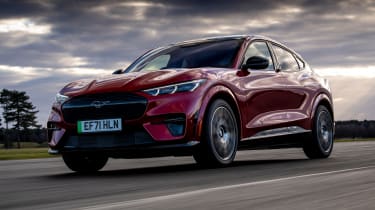
- Model: Mach-E RWD SR
- Price: £50,830
- Power: 75kWh batt./265bhp
If driving enjoyment is your thing, then the Mustang Mach-E is well worth a look. From the base 75kWh model to the 480bhp GT, every variant is entertaining to drive. The steering is sharp, the chassis adjustable, and it really doesn’t feel
hefty in the way you’d expect a 4.7-metre-long electric SUV might.
A 0-62mph time of 6.9 seconds is identical to the Subaru’s, while the throttle response feels sharp in any driving mode. That’s all the more impressive when, at £50,930, the Ford undercuts the Solterra on price. Standard kit includes 18-inch wheels, LED lights, a 360-degree parking camera, wireless smartphone charging and a huge 15.5-inch touchscreen infotainment system.
Any downsides? Well, the flipside of the sharp handling is a ride that might be a little too firm for some, especially those sat in the back. It’s not as spacious as its key rivals (although similar to the Subaru) and its maximum charging speed of 115kW lags behind the competition. That last point is even more costly when, at 273 miles, the Mustang’s official WLTP range is also towards the bottom of the pile.
Hyundai Ioniq 5
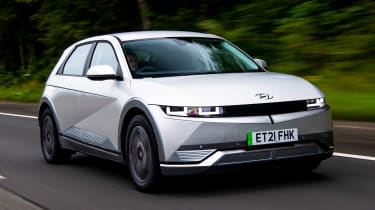
- Model: Ioniq 5 Ultimate 2WD
- Price: £49,595
- Power: 77kWh batt./225bhp
The EV sector moves at a rapid pace, and Hyundai is fully aware that it can’t rest on its laurels – some of which we awarded it when the Ioniq 5 was our Car of the Year in 2021. To that end, the Korean brand has treated the Ioniq 5 to subtle upgrades for 2023, with minor suspension tweaks and optional rear-view cameras in place of side mirrors. But the reasons why we rate the Ioniq 5 so highly remain. The boxy shape results in a roomy cabin – legroom is vast, and headroom is great too - even beside the mechanically similar Kia EV6.
On the road, the Ioniq is the softest car in its class. We don’t mind that – with driving dynamics not the highest of priorities for a near two-tonne crossover, it seems like the right approach to have. Two battery sizes and three power outputs are available, and the sweet spot is the 77kWh/225bhp model that’s capable of 295 miles between charges.
And charging is where the Ioniq 5 really excels. A maximum rate of 220kW means that if you can find a charger that can keep up, it’s possible to charge from 10-80 per cent in less than 20 minutes.
Nissan Ariya
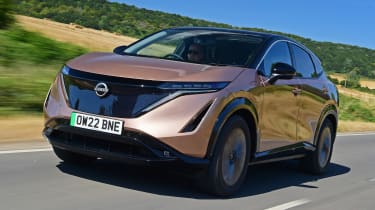
- Model: Ariya 87kWh Advance
- Price: £51,895
- Power: 87kWh batt./239bhp
The Nissan Ariya was our Car of the Year in 2022, and to our eyes it’s the all-electric family SUV to beat. Strong first impressions are made by the cabin, whose minimalist yet functional design and fabulous fit and finish lift it comfortably beyond any of the five alternatives across these pages. The infotainment is a huge step forward over Nissans of old, and there’s loads of space, too, with similar knee and headroom to the Enyaq in the back, although the Nissan’s boot is a little smaller than the Skoda’s.
On the road, the Ariya strikes a similarly strong ride and handling compromise to the Solterra. It’s a touch firmer than the Subaru, but is more compliant than the Ford and certainly the Tesla. Its 130kW charging speeds are similar to the Skoda’s, while the 80kWh battery offers a WLTP-rated range of 322 miles. With 239bhp from the single motor, performance is strong – and there’s a more potent twin-motor option, too. Refinement is even better, with a quiet cabin and near-silent motor making for a great all-round family car.
Tesla Model Y
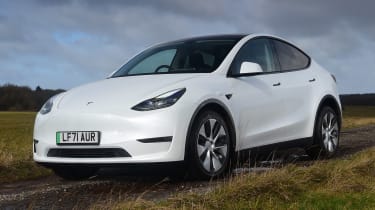
- Model: Model Y Long Range
- Price: £52,990
- Power: 75kWh batt./384bhp
For some buyers, the Model Y remains a no-brainer – and recent price cuts have made it even more affordable. Despite an influx of rivals, Tesla still leads the way in key areas. Efficiency is a huge strong point, and the Model Y Long Range covers 331 miles between charges. That’s as good as the Skoda, yet the Model Y can sprint from 0-62mph in 4.8 seconds.
Perhaps the biggest selling point is Tesla’s Supercharger network. At a time when so many other charge providers insist on awkward apps and unreliable stations, with the Model Y you can just turn up, plug in and then drive off when you’re done; the cost is debited from your bank account monthly.
The huge infotainment screen does away with traditional dials, so it won’t be for everyone. But the car’s software can plot a route via Superchargers and tell you how long you need to plug in for to
complete your journey, which is clever.
In other areas, the Tesla lags behind its rivals here. It’s quick, but the chassis lacks sophistication; body control is below
par, the steering feels artificial and the ride is far too firm for a family SUV.
Figures
| Subaru Solterra Dual Motor Touring | Skoda Enyaq iV 80 SportLine | |
| On the road price/total as tested | £52,995/£53,545 | £46,320/£52,646 |
| Residual value (after 3yrs/36,000) | £30,552/57.7% | £26,852/58% |
| Depreciation | £22,443 | £19,468 |
| Annual tax liability std/higher rate | £212/£424 | £195/£391 |
| Annual elec. cost (12k/20k miles) | £1,526/£2,544 | £1,272/£2,120 |
| Insurance group/quote/road tax cost | 47/£912/£0 | 33/£892/£0 |
| Servicing costs | N/A | £288 (2 years) |
| Length/wheelbase | 4,690/2,850mm | 4,653/2,767mm |
| Height/width | 1,650/1,860mm | 1,605/1,879mm |
| Powertrain | 2x electric motors/lithium-ion battery | 1x electric motor/lithium-ion battery |
| Peak power | 215bhp | 201bhp |
| Peak torque | 337Nm | 310Nm |
| Transmission | Single-speed/4WD | Single-speed/rwd |
| Battery capacity/usable | 75/71.4kWh | 82/77kWh |
| Boot capacity (seats up/down) | 441 litres/N/A | 585/1,710 litres |
| Kerbweight/towing capacity | 2,040/750kg | 2,111/1,200kg |
| Turning circle | 11.2 metres | 10.2 metres |
| Basic warranty (miles)/recovery | 3yrs (60k)/3yrs | 3yrs (60k)/3yrs |
| Driver Power manufacturer/dealer pos | N/A/4th | 20th/16th |
| NCAP: Adult/child/ped./assist/stars | 88/87/79/91/5 (’22) | 91/89/71/82/5 (’21) |
| 0-62mph/top speed | 6.9 secs/100mph | 8.5 secs/99mph |
| AE economy (miles/kWh)/range | 2.5/179 miles | 3.0/231 miles |
| Claimed range (WLTP) | 257 miles | 332 miles |
| Charging capability | 7.2/150kW | 7.2/135kW |
| Charging time | 12hr 45 min/32 min^^ | 13hr/29 min^ |
| CO2/tax bracket | 0g/km/2% | 0g/km/2% |
| Airbags/Isofix/park sensors/camera | Seven/two/f&r/360 | Seven/three/f&r/yes |
| Auto/lane keep/blind spot/AEB | Yes/yes/yes/yes | Yes/yes/yes/yes |
| Climate control/cruise control | Yes/adaptive | Yes/yes |
| Leather/heated seats | Faux/yes | Part/yes |
| Metallic paint/LED lights | £550/yes | £660/yes |
| Keyless go/powered tailgate | Yes/yes | Yes/£565* |
| Sat-nav/digital dashboard | Yes/yes | Yes/yes |
| DAB radio/connected apps | Yes/yes | Yes/yes |
| Wireless charge/CarPlay/Android Auto | Yes/wireless/wireless | Yes/wireless/cable |
Now read our list of the best electric SUVs...

